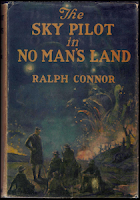In past years I've noted gifts and donations to the Dusty Bookcase at the end of the annual list of Ten Best Book Buys. An exception is made here because of the shear volume, and because I wanted to add a personal note. And We Go On seems an appropriate title with which to start.
And We Go On
Will R. Bird
Toronto: Hunter-Rose, 1930
A memoir of the Great War, this first edition was given to me by military historian James Calhoun, with whom I co-authored the introduction to
the 2014 Dundurn edition of Peregrine Acland's All Else Is Folly. Note the dust jacket description:
A story of the War by a Private in
the Canadian Black Watch;
a Story Without Filth
or Favour.
Bird's memoir was inspired in part by his disgust at the portrayal of soldiers in
All Quiet on the Western Front and
Generals Die in Bed. He wouldn't have liked
All Else Is Folly.
Outlaw Breed
William Byron Mowery
Calabasas, CA: Cutting Edge, 2023
Novelist Lee Greenwood is doing God's work in reviving neglected novels. He reached out three years ago after I reviewed former
Vancouver Sun scribe Tom Ardies' 1971 thriller
Their Man in the White House. You'd like it. The novel tells the story of an American president who is beholding to the Russians. Oh, and he has an unusual – I suggest unhealthy – relationship with his blonde daughter. Lee was then in the process of returning all Ardies' novels to print.
Outlaw Breed is not a political thriller. First published in 1936 under the title Black Automatic, it was written by a Buckeye known as the "Zane Grey of the Canadian Northwest." Starring Noel Irving, ex-RCMP, the action begins with a murder in Winnipeg, moves on to Fort McMurray, and then the Northwest Territories.
The Woman's Harvest
Anna Floyd
London: T. Werner Laurie, 1916
An obscure novel by a forgotten English writer, set in England in and around the time of the Great War,
The Woman's Harvest has nothing whatsoever to do with Canada, yet I was drawn to it after reading
Brad Bigelow's Neglected Books review. I just had to read it, but not a one was listed for sale online. Worse still, the nearest copy is found in the National Library of Scotland. Brad was generous in giving me his. I'll say no more because Brad's review says it all. You'll want to read it, too.
and Other Poems of the War
Charles G.D. Roberts
Toronto: Ryerson, 1941
The River St. John and Its Poets
L.M.B. Maxwell
[n.p.]: [n.p], 1946
Two chapbooks donated by my friend Forrest Pass. The earlier, Sir Charles' Canada Speaks of Britain features seven "Poems of the War" (including 'Peace With Dishonour,' which was actually composed in September, 1938), along with three poems from the previous war, and three more poems thrown in for good measure. The longest in the collection is 'Two Rivers':
Two rivers are there in hold my heart
And neither would I leave.
When I would stay with one two long
The other tugs my sleeve.
The two rivers are the Tantamar and the St. John, which ties in nicely to
The River St. John and Its Poets by L.M.B. Maxwell, LL.D. It consists of a series of biographical sketches and sample poems of sixteen poets, including Sir Charles G.D. Roberts, LL.D., D. Litt.; Theodore Goodrich Roberts, D. Litt.; William Bliss Carman, M.A., LL. D.; and Alfred Goldsworthy Bailey, M.A., Ph.D. I was more interested in plain old Francis Sherman, Charles Boyle, and Elizabeth Roberts MacDonald, whose
home I visited last autumn.
The Complete Adventures of Jimmie Dale, Volume Three
Frank L. Packard
[n.p.]: [n.p], 2022
The final volume of Packard scholar Michael Howard's annotated compilation of Packard's Gray Seal novels, this one includes
Jimmie Dale and the Blue Envelope Murder (1930),
Jimmie Dale and the Missing Hour (1935), and the unfinished and previously unpublished
Jimmie Dale's Only Chance.
But wait, there's more!
Also included are four chapters that were cut from
The Further Adventures of Jimmie Dale (1919), the script for the first episode of the radio serial
The Adventures of Jimmie Dale, the beginning of the British edition of
The Adventures of Jimmie Dale (in which our hero is an Englishman), and a family biography by the late Francis Lucius Packard.
The author's grandson, Jeffrey Packard, provides the preface.
All three volumes can be ordered through Amazon.
One last gift:
Self Condemned
Wyndham Lewis
Toronto: Dundurn, 2010
My friend Michael Gnarowski died on July 27th of this year. He'd taught at three universities, one of which I attended, but I was not one students. Still, I learned a great deal from Michael. We first met twenty years ago when I was working on
my biography of of his friend John Glassco, that great practitioner of deceit. He and I were dogged in our pursuit of "the knowable truth."
Our last days together started over pints in an Ottawa strip mall pub – the serving of fish and chips wasn't bad – after which we'd move on to apple pie and vanilla ice cream at the flat he shared with his wife Diana. In our second to last meeting, Michael pulled out this slightly battered copy
Self Condemned, asking whether I had a copy.
I lied.
This edition is a Voyageur Classic, a series that followed the Carleton Library and the Centre for Editing Early Canadian Texts series, all of which Michael had overseen. I'd bought each Voyageur Classic upon release, and was honoured when he accepted my proposal to include All Else Is Folly (see above) in the series.
I lied to accept his generosity. Michael signed my copy, frustrated that his writing hand would not do what he wanted it to.
I last saw Michael on Father's Day, which somehow seems appropriate. He ordered the fish and chips, and then we had pie and ice cream.
17 September 1934, Shanghai, China
July 27, 2023, Ottawa, Canada
RIP





















































